Chapter 5. Nucleotides & Nucleic Acids
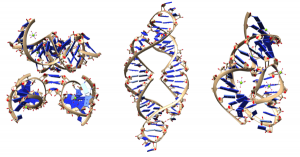
Chapter Outline
- 5.1 Nucleotides and the Phosphodiester Bond
- 5.2 Deoxyribonucleic acid: DNA
- 5.3 Ribonucleic acid: RNA
Introduction
Nucleic acids are macromolecules made up of monomers called nucleotides. They are the most important macromolecules for the continuity of life. They carry the genetic information of a cell and instructions for the functioning of the cell. Nucleic acids are information molecules that serve as blueprints for the proteins that are made by cells. They are also the hereditary material in cells, as reproducing cells pass the blueprints on to their offspring.
The two main types of nucleic acids are deoxyribonucleic acid (DNA) and ribonucleic acid (RNA). DNA is the genetic material found in all living organisms. It is found in the nucleus of eukaryotes and in the chloroplasts and mitochondria. In prokaryotes, the DNA is not enclosed in a nucleus.
The entire genetic content of a cell is known as its genome. In eukaryotic cells, DNA forms a complex with histone proteins to form chromatin, the substance of eukaryotic chromosomes. A chromosome may contain tens of thousands of genes. Many genes contain the information to make protein products; other genes code for RNA products. DNA controls all of the cellular activities by turning the genes “on” or “off.”
The other type of nucleic acid, RNA, is mostly involved in protein synthesis. DNA molecules use an intermediary, called messenger RNA (mRNA), to communicate with the rest of the cell. Other types of RNA, such as rRNA, tRNA, and microRNA, are involved in protein synthesis and its regulation.
5.1 | Nucleotides and the Phosphodiester Bond
Learning Objectives
By the end of this section, you will be able to:
- Identify the three components of nucleotide structure.
- Recognize how nucleotides and nucleic acids are related.
- Name the type of bond that holds nucleotides together & identify it in a nucleic acid structure.
DNA and RNA are made up of monomers known as nucleotides. The nucleotides combine with each other to form a nucleic acid, DNA or RNA. Each nucleotide is made up of three components: a nitrogenous base, a pentose (five-carbon) sugar, and a phosphate group (Figure 5.2). Each nitrogenous base in a nucleotide is attached to a sugar molecule, which is attached to one or more phosphate groups.
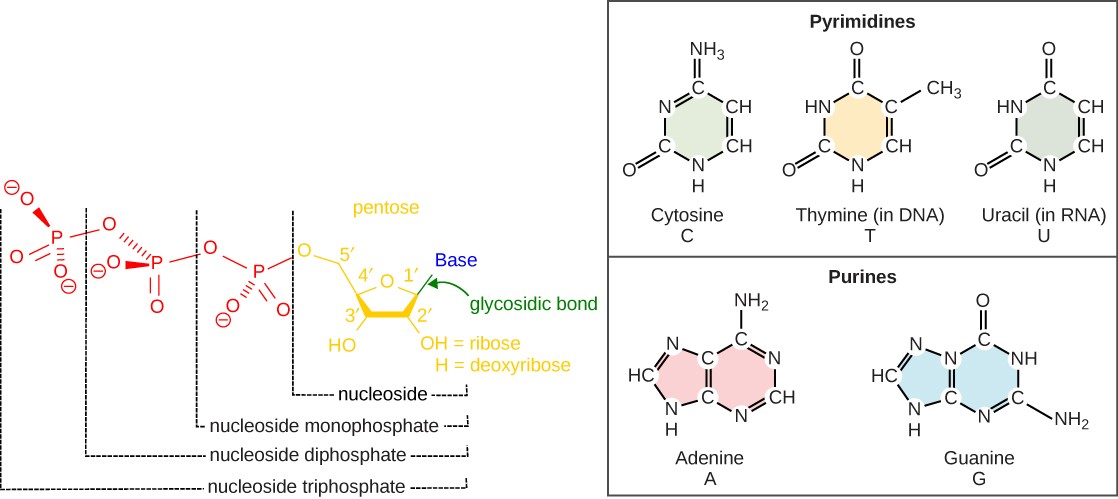
The nitrogenous bases are organic molecules that contain nitrogen. They are bases because they contain an amino group that has the potential of binding an extra hydrogen. Each nucleotide in DNA contains one of four possible nitrogenous bases: adenine (A), guanine (G) cytosine (C), and thymine (T). Each nucleotide in RNA contains one of four possible nitrogenous bases: adenine (A), guanine (G) cytosine (C), and uracil (U). Adenine and guanine are classified as purines and have two carbon-nitrogen rings. Cytosine, thymine, and uracil are classified as pyrimidines, which have a single carbon-nitrogen ring (Figure 5.2).
The carbon atoms of the pentose sugar molecule in each nucleotide are numbered as 1′, 2′, 3′, 4′, and 5′ (1′ is read as “one prime”). The nitrogenous base is attached to the 1′ carbon and the phosphate group is attached to the hydroxyl group of the 5′ carbon. In RNA, the pentose sugar is ribose, which has a hydroxyl group attached to the 2′ carbon. In DNA, the pentose sugar is deoxyribose, which has a hydrogen atoms attached to the 2′ carbon. The “deoxy” in the name of DNA refers to the missing oxygen atom at the 2′ carbon (Figure 5.2).
Nucleic acids are long, linear chains of nucleotides. Phosphodiester linkages are covalent bonds between the 3′ carbon of one nucleotide and the 5′ phosphate group of another. They form by dehydration synthesis reactions (Figure 5.3). Nucleic acids have directionality: the first nucleotide in the chain has a free phosphate group at the 5′ end of the molecule. The last nucleotide added has a free 3′ hydroxy group at the 3′ end of the molecule. Nucleotides are always added on to the 3′ end.
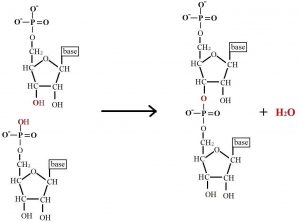
5.2 | Deoxyribonucleic Acid: DNA
Learning Objectives
By the end of this section, you will be able to:
- Describe the structure and role of DNA.
- Discuss the similarities and differences between eukaryotic and prokaryotic DNA.
5.2.1 The Double Helix
In the 1950s, Francis Crick and James Watson worked together to determine the structure of DNA at the University of Cambridge, England. Other scientists like Linus Pauling and Maurice Wilkins were also actively exploring this field. Pauling had discovered the secondary structure of proteins using X-ray crystallography. In Wilkins’ lab, researcher Rosalind Franklin was using X-ray diffraction methods to understand the structure of DNA. Watson and Crick were able to piece together the puzzle of the DNA molecule on the basis of Franklin’s data because Crick had also studied X- ray diffraction (Figure 5.4). In 1962, James Watson, Francis Crick, and Maurice Wilkins were awarded the Nobel Prize in Medicine. Unfortunately, by then Franklin had died, and Nobel prizes are not awarded posthumously.
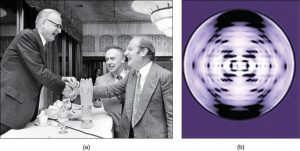
Watson and Crick correctly proposed that DNA is made up of two strands that are twisted around each other to form a right-handed helix. Two strands of nucleotides are held together by hydrogen bonds that form between pairs of nitrogenous bases. The sugar and phosphate “backbone” forms the outside of the helix. The nitrogenous bases are stacked in the interior, like the steps of a ladder. The two strands are anti-parallel in nature; that is, the 3′ end of one strand faces the 5′ end of the other strand (Figure 5.5).
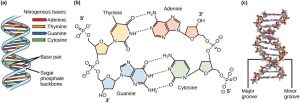
Only certain types of base pairing occur. A can only pair with T, and G can only pair with C, as shown in Figure 5.5. This is known as the base complementary rule. In other words, the DNA strands are complementary to each other. If the sequence of one strand is 5′-AATTGGCC-3′, the complementary strand would have the sequence 3′-TTAACCGG-5′. The fact that the two strands of a DNA molecule are complementary allows DNA to replicate. During DNA replication, each strand is copied, resulting in a daughter DNA double helix containing one parental DNA strand and a newly synthesized strand. The base pairs are stabilized by hydrogen bonds; adenine and thymine form two hydrogen bonds and cytosine and guanine form three hydrogen bonds.
Concept Check
A mutation occurs, and cytosine is replaced with adenine. What impact do you think this will have on the DNA structure?
5.2.2. DNA Packaging in Cells
When comparing prokaryotic cells to eukaryotic cells, prokaryotes are much simpler than eukaryotes in many of their features (Figure 5.6). Most prokaryotes contain a single, circular chromosome that is found in an area of the cytoplasm called the nucleoid.
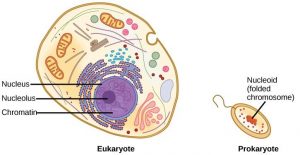
The size of the genome in one of the most well-studied prokaryotes, E. coli, is 4.6 million base pairs (approximately 1.1 mm, if cut and stretched out). So how does this fit inside a small bacterial cell? The DNA is twisted by what is known as supercoiling. Supercoiling means that DNA is either under-wound (less than one turn of the helix per 10 base pairs) or over-wound (more than 1 turn per 10 base pairs) from its normal relaxed state. Some proteins are known to be involved in the supercoiling; other proteins and enzymes, such as DNA gyrase, help in maintaining the supercoiled structure.
Eukaryotes, whose chromosomes each consist of a linear DNA molecule, employ a different type of packing strategy to fit their DNA inside the nucleus (Figure 5.7). At the most basic level, DNA is wrapped around proteins known as histones to form structures called nucleosomes. The histones are evolutionarily conserved proteins that are rich in basic amino acids and form an octamer. The DNA (which is negatively charged because of the phosphate groups) is wrapped tightly around the histone core. This nucleosome is linked to the next one with the help of a linker DNA. This is also known as the “beads on a string” structure. This is further compacted into a 30 nm fiber, which is the diameter of the structure. At the metaphase stage, the chromosomes are at their most compact, are approximately 700 nm in width, and are found in association with scaffold proteins.
In interphase, eukaryotic chromosomes have two distinct regions that can be distinguished by staining. The tightly packaged region is known as heterochromatin, and the less dense region is known as euchromatin. Heterochromatin usually contains genes that are not expressed (not actively transcribed to make a product), and is found in the regions of the centromere and telomeres. The euchromatin usually contains genes that are transcribed, with DNA packaged around nucleosomes but not further compacted.

5.3 | Ribonucleic Acid: RNA
Learning Objectives
By the end of this section, you will be able to:
- Explain the structure and roles of RNA.
- Compare and contrast the two types of nucleic acids.
Ribonucleic acid, or RNA, is mainly involved in protein synthesis. Like DNA, RNA is made of nucleotides linked by phosphodiester bonds. However, the nucleotides in RNA contain ribose sugar instead of deoxyribose and the nitrogenous base uracil (U) instead of thymine (T). Unlike DNA, RNA is usually single-stranded. However, most RNAs show internal base pairing between complementary sequences, creating a three-dimensional structure essential for their function.
There are four major types of RNA: messenger RNA (mRNA), ribosomal RNA (rRNA), transfer RNA (tRNA), and microRNA (miRNA). mRNA carries a copy of the genetic code from DNA. If a cell requires a certain protein to be synthesized, the gene is turned “on” and the corresponding messenger RNA is synthesized. The RNA sequence is complementary to the sequence of the DNA (except U replaces T). If the DNA strand has a sequence 5′-AATTGCGC-3′, the sequence of the complementary RNA is 3′-UUAACGCG-5′. The mRNA then interacts with ribosomes and other cellular machinery so that a protein can be made from the coded message. The mRNA is read in sets of three bases known as codons. Each codon codes for a single amino acid.
Thus, information flow in an organism goes from DNA to mRNA to protein. DNA dictates the sequence of mRNA in a process known as transcription, and RNA dictates the structure of protein in a process known as translation. This is known as the Central Dogma of Molecular Biology.
rRNA is a major constituent of ribosomes, to which the mRNA binds to make a protein product. tRNA carries the correct amino acid to the site of protein synthesis. miRNAs play a role in the regulation of gene expression. Table 4.2 summarizes features of DNA and RNA.
Table 4.2 Features of DNA and RNA
|
|
DNA |
RNA |
|
Carries genetic information |
Involved in protein synthesis and regulation of gene expression |
|
|
Location |
Remains in the nucleus |
Leaves the nucleus |
|
Structure |
Double helix |
Usually single-stranded |
|
Sugar |
Deoxyribose |
Ribose |
|
Pyrimidines |
Cytosine, thymine |
Cytosine, uracil |
|
Purines |
Adenine, guanine |
Adenine, guanine |

